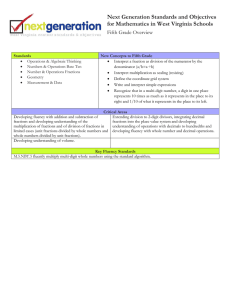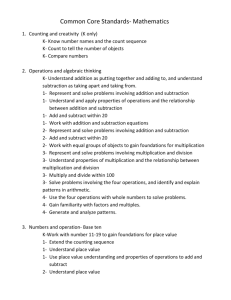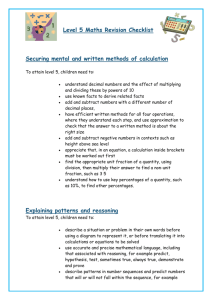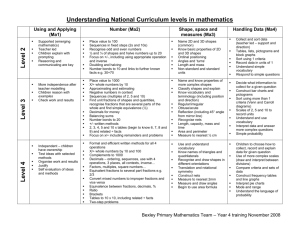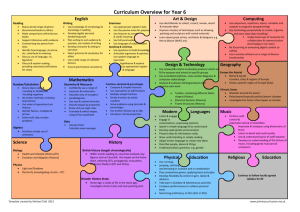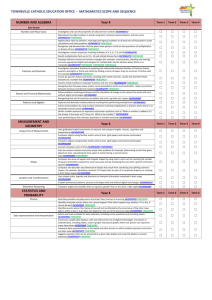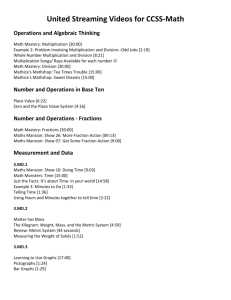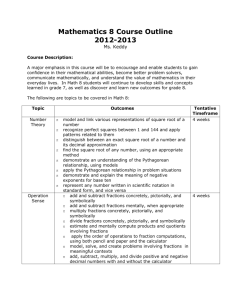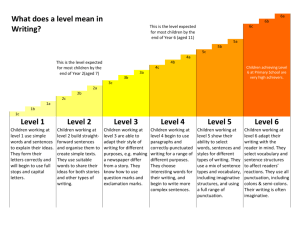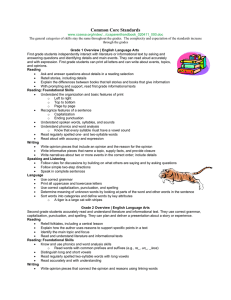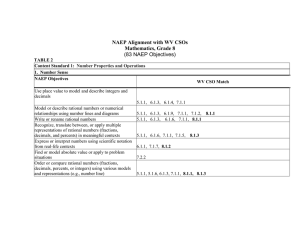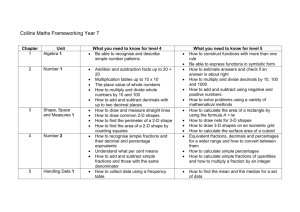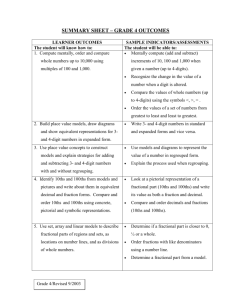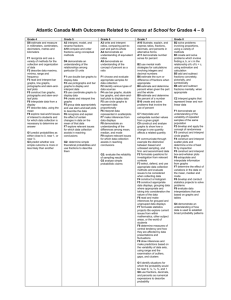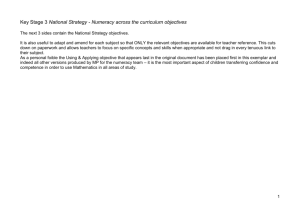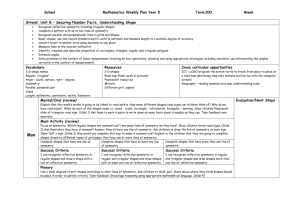4th Grade Objectives
advertisement
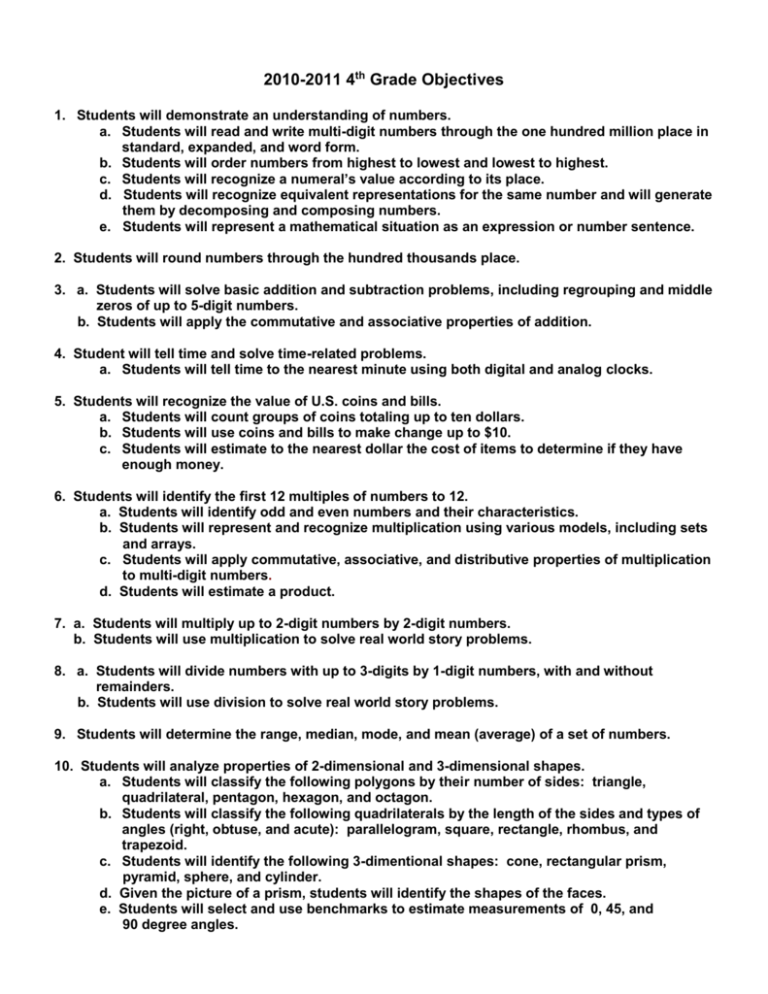
2010-2011 4th Grade Objectives 1. Students will demonstrate an understanding of numbers. a. Students will read and write multi-digit numbers through the one hundred million place in standard, expanded, and word form. b. Students will order numbers from highest to lowest and lowest to highest. c. Students will recognize a numeral’s value according to its place. d. Students will recognize equivalent representations for the same number and will generate them by decomposing and composing numbers. e. Students will represent a mathematical situation as an expression or number sentence. 2. Students will round numbers through the hundred thousands place. 3. a. Students will solve basic addition and subtraction problems, including regrouping and middle zeros of up to 5-digit numbers. b. Students will apply the commutative and associative properties of addition. 4. Student will tell time and solve time-related problems. a. Students will tell time to the nearest minute using both digital and analog clocks. 5. Students will recognize the value of U.S. coins and bills. a. Students will count groups of coins totaling up to ten dollars. b. Students will use coins and bills to make change up to $10. c. Students will estimate to the nearest dollar the cost of items to determine if they have enough money. 6. Students will identify the first 12 multiples of numbers to 12. a. Students will identify odd and even numbers and their characteristics. b. Students will represent and recognize multiplication using various models, including sets and arrays. c. Students will apply commutative, associative, and distributive properties of multiplication to multi-digit numbers. d. Students will estimate a product. 7. a. Students will multiply up to 2-digit numbers by 2-digit numbers. b. Students will use multiplication to solve real world story problems. 8. a. Students will divide numbers with up to 3-digits by 1-digit numbers, with and without remainders. b. Students will use division to solve real world story problems. 9. Students will determine the range, median, mode, and mean (average) of a set of numbers. 10. Students will analyze properties of 2-dimensional and 3-dimensional shapes. a. Students will classify the following polygons by their number of sides: triangle, quadrilateral, pentagon, hexagon, and octagon. b. Students will classify the following quadrilaterals by the length of the sides and types of angles (right, obtuse, and acute): parallelogram, square, rectangle, rhombus, and trapezoid. c. Students will identify the following 3-dimentional shapes: cone, rectangular prism, pyramid, sphere, and cylinder. d. Given the picture of a prism, students will identify the shapes of the faces. e. Students will select and use benchmarks to estimate measurements of 0, 45, and 90 degree angles. 11. Students will use congruent figures to demonstrate a flip/reflection, slide/translation, and turn/rotation. 12. a. Students will identify intersecting, parallel, and perpendicular lines. b. Describe movement using common language and geometric vocabulary (forward, back, left, right, north, south, east, west) 13. Students will calculate the area and perimeter of a polygon and non-polygon using a grid and basic math operations. 14. Students will describe geometric and numeric patterns. a. Students will create a symmetrical design in a given space using at least 3 different pattern blocks. b. Students will subdivide, combine, and transform shapes. c. Students will identify and explain pattern relationships with numbers, including constant rates of change. d. Students will construct a figure with multiple lines of symmetry and identify the lines of symmetry. e. Students will analyze patterns using words, tables, and graphs. 15. Students will recognize and use basic fractions. a. Students will find equivalent fractions by multiplying or dividing the numerator and denominator by the same number. b. Students will reduce fractions to lowest terms (simplest form). c. Students will compare fractions as greater than less than, and equal. 16. Students will add and subtraction fractions with like denominators. 17. Students will compare objects to determine reasonable units of measurement. a. Students will estimate appropriate uses of weight in ounces, pounds, and tons. b. Students will estimate appropriate uses of capacity in cups, pints, quarts, and gallons. c. Students will estimate appropriate uses of length in inches, feet, and yards and identify equivalent linear measurements. 18. Students will measure fractional parts of an inch to the nearest ½ inch. 19. Students will add and subtract decimals in the form of money. 20. Students will construct, interpret, and read data through graphic form. a. Students will create and interpret bar graphs, line graphs, pictographs, and Venn diagrams, and line plots. b. Students will create and interpret circle graphs. c. Students will create and interpret tables and charts to construct a graph. d. Students will describe and/or graph mathematical relationships showing a constant rate of change. e. Students will analyze patterns using words, tables, and graphs. 21. Students will determine possible outcomes of an event. a. Students will draw a tree diagram to show possible outcomes. b. Students will use fractions to describe the possibility of an event. c. Students will determine if situations are fair or unfair. 22. Students will apply problem-solving strategies to solve multi-step real-world story problems.
